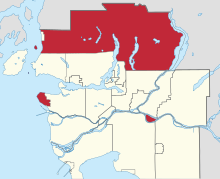Metro Vancouver Electoral Area A
Electoral Area A | |
|---|---|
| Metro Vancouver Electoral Area A | |
 Location of Electoral Area A in Metro Vancouver | |
| Country | Canada |
| Province | British Columbia |
| Regional district | Metro Vancouver |
| Regional district office | Metrotower III[1] |
| Government | |
| • Director | Jen McCutcheon |
| Area | |
| • Land | 815.21 km2 (314.75 sq mi) |
| • Urban | 14.49 km2 (5.59 sq mi) |
| • Rural | 800.72 km2 (309.16 sq mi) |
| [Note 1] | |
| Population (2021)[3] | |
| 18,612 | |
| • Density | 22.8/km2 (59/sq mi) |
| • Urban | 18,296 |
| • Urban density | 1,300/km2 (3,300/sq mi) |
| • Rural | 316 |
| • Rural density | 0.39/km2 (1.0/sq mi) |
| Time zone | UTC-8 (Pacific Standard Time) |
| • Summer (DST) | UTC-7 (Pacific Daylight Time) |
| Area codes | 604, 778, 236, 672 |
Metro Vancouver Electoral Area A is a part of Metro Vancouver in British Columbia. It includes several unincorporated areas: the University Endowment Lands and the University of British Columbia, west of the City of Vancouver; Bowyer, Passage, and Barnston Islands; the west side of Pitt Lake; the northern portion of Indian Arm; and a large area to the north of the North Shore that is mostly mountainous and sparsely populated except for certain subdivisions between Horseshoe Bay and the Village of Lions Bay.
The Electoral Area is represented by a director on the board of the regional district. This is an elected position, with a four-year term. The current director is Jen McCutcheon.[2]
Communities
[edit]- Barnston Island
- Buntzen Bay
- Gambier Island Trust Area (part)
- Granite Falls
- Strachan Creek
- University Endowment Lands
Demographics
[edit]In the 2021 Census, Statistics Canada reported that Metro Vancouver A had a population of 18,612 living in 7,682 of its 9.201 total dwellings, a 15.4% change from its 2016 population of 16,133. With a land area of 815.21 km2 (314.75 sq mi), it had a population density of 22.8/km2 (59.1/sq mi) in 2011.[3]
| Area | Population | % change 2016-2021 | |
|---|---|---|---|
| 2016 | 2021 | ||
| UBC campus | 12,908 | 15,103 | +17.0% |
| Rest of UEL | 2,982 | 3,193 | +7.1% |
| Total urban population | 15890 | 18296 | +15.1% |
| Barnston Island | 127 | 111 | -12.6% |
| Howe Sound communities (including Passage and Bowyer Islands) | 72 | 104 | +44.4% |
| Indian Arm/Pitt Lake communities | 44 | 101 | +129.5% |
| Total rural population | 243 | 316 | +30% |
| Electoral Area A | 16,133 | 18,612 | 15.4% |
| Ethnicity | Population | % of Total Population | |
|---|---|---|---|
| Visible minority groups[6] | South Asian | 300 | 2.7% |
| Chinese | 3,370 | 30.8% | |
| Black | 155 | 1.4% | |
| Filipino | 20 | 0.2% | |
| Latin American | 170 | 1.6% | |
| Arab | 190 | 1.7% | |
| Southeast Asian | 110 | 1% | |
| West Asian | 390 | 3.6% | |
| Korean | 1,025 | 9.4% | |
| Japanese | 255 | 2.3% | |
| Other visible minority | 15 | 0.1% | |
| Mixed visible minority | 25 | 0.2% | |
| Total visible minority population | 6,040 | 55.2% | |
| Aboriginal groups[7] | First Nations | 60 | 0.5% |
| Métis | 0 | 0% | |
| Inuit | 0 | 0% | |
| Total Aboriginal population | 55 | 0.5% | |
| White | 4,840 | 44.3% | |
| Total population | 10,935 | 100% | |
Notes
[edit]See also
[edit]References
[edit]- ^ "Metro Vancouver Board of Directors - Contact Information" (PDF). Metro Vancouver Regional District. February 28, 2022. Retrieved August 9, 2022.
- ^ a b "Board Members". Metro Vancouver. Retrieved May 14, 2015.
- ^ a b c Government of Canada, Statistics Canada (2022-02-09). "Profile table, Census Profile, 2021 Census of Population - Metro Vancouver A, Regional district electoral area (RDA) [Census subdivision], British Columbia". www12.statcan.gc.ca. Retrieved 2022-08-10.
- ^ "Urban Containment". www.metrovancouver.org. Retrieved 2022-08-10.
- ^ a b c d "About Electoral Area A". www.metrovancouver.org. Retrieved 2022-08-10.
- ^ "File not found | Fichier non trouvé". www12.statcan.gc.ca. Retrieved 2022-08-10.
- ^ [1], Aboriginal Peoples - Data table
